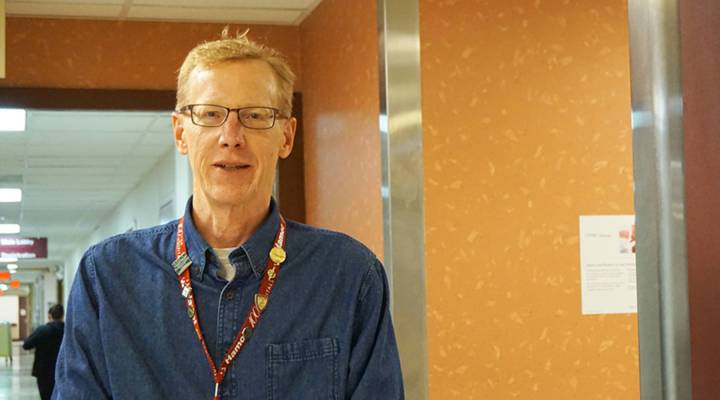
How health care is healing Erie’s ailing economy
How health care is healing Erie’s ailing economy

President Trump pledged sweeping political and economic changes during the campaign. We have no idea if Trump can deliver on those promises, but we can explore what it’s going to take for him to try. It’s all in our series The Big Promise.
Like a lot of people in Erie, Marc Bryant spent decades in manufacturing. He was an engineer at Hammermill Paper, which became International Paper. And then the mill closed in 2002. Bryant said some of his co-workers retired. Others, “honestly, ended up on a bar stool somewhere complaining about how things were bad until their benefits ran out,” he said.
And the rest did what he did.
“I elected to, at the age of 48, take a leap of faith and go back to college,” he said.
That was 15 years ago. Today Bryant is a registered nurse at the University of Pittsburgh Medical Center Hamot, one of Erie’s two largest hospitals. He said he occasionally runs into guys at the hospital he used to work with at the paper mill. Not surprising, given that health care has become what manufacturing used to be – Erie’s biggest industry.
But Erie didn’t get there on its own.
It had a big assist from Pittsburgh, which is just a couple hours away and brought its own economy back from the brink by turning to health care after the steel industry collapsed.
And when Pittsburgh’s two biggest health care systems — UPMC and Allegheny Health Network — needed new territory to conquer, they turned to Erie, and folded its biggest hospitals into their systems.

Hamot Hospital was acquired by the University of Pittsburgh Medical System seven years ago. Since then, the hospital has expanded and launched specialties.
Competition between the two systems at the time was fierce. But when they came to Erie seven years ago, “that wasn’t really what happened here,” said Scott Whalen, CEO of Saint Vincent Hospital, which is part of Allegheny Health Network.
But it’s happening now. Each system is sinking $100 million into new construction. They’re both offering new specialties. And the doctor poaching is nonstop.
Take Muhammad Asad, a bariatric surgeon. He works at UPMC Hamot, but he used to work at Saint Vincent Hospital. What made him cross the line? The promise of a new assistant in the form of a $2 million robot.
“You go to any city of this magnitude and there will be two or three hospitals, and there will be always competition, and that’s a healthy thing,” he said.

The robot used in surgery costs upward of two million dollars.
Healthy as in jobs. Erie’s two big hospital systems employ nearly 7,000 people. And then there are the other medical-related jobs created by those jobs. There’s also a medical school and a big insurance industry, not to mention a lot of related nonmedical ones, too, like construction.
Bryant, who made that shift from the paper factory to nursing, said outsiders might think of Erie in terms of manufacturing, but it’s a health care town now.
“I mean, this is a very, very core thing to the community,” he said.
And so far, Erie isn’t paying the typical price for those jobs in more expensive health care.
Paul Ginsburg, director of health policy at the Brookings Institution, said when the big guys buy up the little guys, it doesn’t always end well.
| Erie public schools are consolidating to survive |
| Erie depends on immigrants to boost its economy |
| Rural America weighs the economic realities of proposed federal budget cuts |
“There’s been an accumulation of research that has shown that hospital mergers raise prices in the community, and as far as whether they improve quality, there’s just no evidence that this happens,” he said. But in this case, “The added premiums that come from more jobs in health care, much of that is paid for by people outside of Erie.”
People like the woman having the weight-loss surgery. Erie is a big draw for out-of-towners in need of specialized medical procedures they can’t get at home. And then there’s that other out-of-towner — the federal government. A big percentage of Erie’s residents are covered by Medicaid and Medicare.
“So, in its narrow interest, a community like Erie does benefit,” Ginsburg said.
But if the Republican health care bill goes through and Medicaid funding is slashed, economists say hospitals could lose those government health care dollars. And that could put a chill on expansion plans and job growth, and bring a whole lot of pain to a community still trying to rebuild its economy.
There’s a lot happening in the world. Through it all, Marketplace is here for you.
You rely on Marketplace to break down the world’s events and tell you how it affects you in a fact-based, approachable way. We rely on your financial support to keep making that possible.
Your donation today powers the independent journalism that you rely on. For just $5/month, you can help sustain Marketplace so we can keep reporting on the things that matter to you.


















